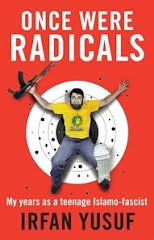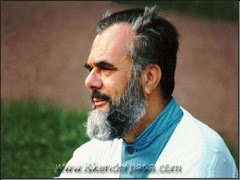In many parts of Pakistan, meals are prepared in an underground oven known as a “tandoor”, typically carved out of the bare earth using bricks. From this oven is prepared various forms of kebabs, ‘tikka’ and even traditional bread known as ‘naan’. It is not uncommon to see roadside cafes where food is prepared in this manner.
I spent 6 months living in Karachi. I was 7 years old at the time. Each day, I would cross Alfalah Road and grab some “tandoori roti” (as we used to call naan) for our domestic consumption. I would watch as the chef would manipulate the dough inside the oven using two metal sticks. Sometimes the bread so deep into the oven that his head would almost enter the oven.
And that pretty much sums up the attitude of many Pakistani and other migrant Muslim parents, whether it be in Australia, New Zealand, France or the UK. Heads in the tandoor.
I read that 4 bright middle class Pakistani boys grab their Jamaican friend, stuff backpacks with bombs and pull off an explosive attack that sends shockwaves around the world. I hear all sorts of explanations and theories, from the sublime to the ridiculous. So why do migrant kids do this sort of thing? And why would kids with seemingly everything going for them, with middle class backgrounds and good education and family support, indulge in this sort of ghastly act?
I really have no idea. I will not hazard a guess. I am no expert in terrorism or in Middle Eastern politics. But I do know what it is like to work with young kids.
Growing Up As An Urdu-Speaker in Sydney
At age 16, I attended my first Muslim youth camp. I had just finished Year 10 at St Andrews Cathedral School. I was one of a small number of Indo-Pakistani kids at this camp.
Up until that time, I associated Islam with Indian culture and Hindi/Urdu language. My parents were on a mission to ensure that I learn to speak their first language fluently. They reasoned that I would learn English anyway at school and with friends. But at home, it was Urdu/Hindi only.
And how did we learn our language and our culture? By mixing with people who spoke that language. And so my “Muslim” friends included Hindus, Sikhs, Goan Catholics and even the kids of a Pakistani-born Anglican minister. We used to commemorate Deevali and Holi with our Hindu friends. We had a Christmas tree in the house. And we had Ramadan and the Eid feasts.
I learnt to read the Qur’an in Arabic, though reciting it with a more Indian accent. I never quite knew the meaning. But I did know that if I finished reading it then I would have a huge party at the end.
I was also taught how to say the five daily prayers (called ‘namaz’, a Persian word borrowed from Zoroastrian tradition). But I never understood its meaning.
Academic Expectations
But real Pakistani religion for kids was being at the top of the class. Being high achievers was what it was all about. And most important was to eventually become a doctor. If you weren’t a high achiever, the community rejected you.
One poor Pakistani boy found himself unable to achieve academically. He was an extremely intelligent young man with an extraordinary artistic ability. He was a born actor, and possessed a comic genius that many (including myself) admired and envied. But his inability to give his parents something to boast about academically made him into a social outcast. He succumbed to depression and eventually committed suicide.
Cultural Artifacts & Discrimination
Pakistani Islam is more of a cultural artefact. And it is about displaying that artefact. Because display and appearance is emphasised more than reality, the degree of hypocrisy is extraordinary. And much of this is directed at girls.
My sisters could never go out after dark. I could. My sisters were never allowed to go to an Islamic camp. I was. My sisters could not stay over at friends’ houses overnight. I could. In many respects, I was spoilt rotten.
Pakistani girls and boys are not encouraged to mix and mingle. For girls, the fear of losing one’s reputation is pervasive. For boys, there is the fear that the girl will attempt to protect herself by telling everyone the boy is a loafer.
Identity, Depression, Anger, Rebellion
I could write so many paragraphs about this. Basically, it boils down to the fact that Pakistani kids are growing up confused. Some become depressed. Others become angry. And most rebel at some stage of their lives. This is where the danger begins. And this might provide some clues as to the motives of the young men from Leeds who dragged themselves and 60 others to their deaths.
Rebellion can take the form of lots of sex and drugs and rock ‘n’ roll. But sometimes it can also take the form of a loud and rebellious form of religiosity. Many Pakistani kids find little support structures in existence in their mosques or cultural organisations.
Irrelevant Mosques & Imams
Pakistani mosques are typically managed by a cocktail of suburban GP’s and taxi drivers. The executive committee functions as a highly politicised affair, with mosque elections frequently characterised by vote-rigging and even minor violence (chairs being thrown around the room etc). Few mosque societies have their books and legalities in order.
Imams of Pakistani mosques tend to be imported from a madressa (seminary) in Pakistan. Usually these imams have little or no command of English, and very little understanding of mainstream Australian culture. Their role is generally limited to leading the daily prayer services, teaching children how to read the Qur’an in Arabic, advising people on religious and cultural matters and providing some religious legitimacy to controversial decisions of the mosque executive.
Imams are often engaged on a temporary basis, and their immigration status is subject to sponsorship of the committee. Many imams find themselves embroiled in the factional politics of the mosque, and are forced to take sides in order to keep their post. This is especially the case when the imam is related to one of the factional heavies.
So when a young Pakistani Muslim kid or teenager has a problem s/he finds it difficult to find an imam who can provide any coherent advice. The same story is repeated in other cultural communities (with the possible exception of Turkish communities where imams tend to be young and try to organise sporting and other events for young people).
As a result, many young Muslim Australians and Britons (and, to a lesser extent, Canadians and Britons) are forced to find assistance and identity by reading books or by attending sessions with teachers not associated with mainstream mosques. Some of these teachers have attended courses of varying lengths in Saudi Arabia. They return with fringe literalist views reflective of what has become known in mainstream Muslim circles as the “salafite cult”.
The Salafite Cult – Filling the Vacuum
Salafitism is a cult. It cannot be called a sect. It has such small representation in the Muslim world that labelling it a sect would be giving it more credit than it deserves. Shia Muslims form a minority sect, making up around 10% of the Muslim world and enjoying healthy majorities in Iraq, Iran, Azerbaijan and some Gulf states. They also have significant minorities in Pakistan, Afghanistan, Lebanon and Saudi Arabia.
Salafite cultists, on the other hand, would be lucky to constitute 0.5% of the Muslim community internationally. They tend to congregate in Western countries, taking advantage of sponsorship from Saudi Arabian religious authorities. Many salafite imams are able to attract young people as they speak quite fluent English and can provide an abundance of literature.
Salafite cultism attracts young Muslims for similar reasons that some fundamentalist and fringe Christian groups attract young nominally Christian youth. They tend to involve a charismatic leader. They involve a simple literalist rendition of theology and understanding scripture.
Mainstream imams cannot compete with well-resourced and English-speaking salafite cultists, many of whom are young people who studied in Saudi Arabia and who are being funded by Saudi religious authorities.
Further, because many Aussie Muslim kids are unable to identify and differentiate between fringe and mainstream ideas, they are taken by salafite rhetoric which appears to comply more with some literal and non-contextual understandings of the texts.
To be continued …
© Irfan Yusuf 2005










